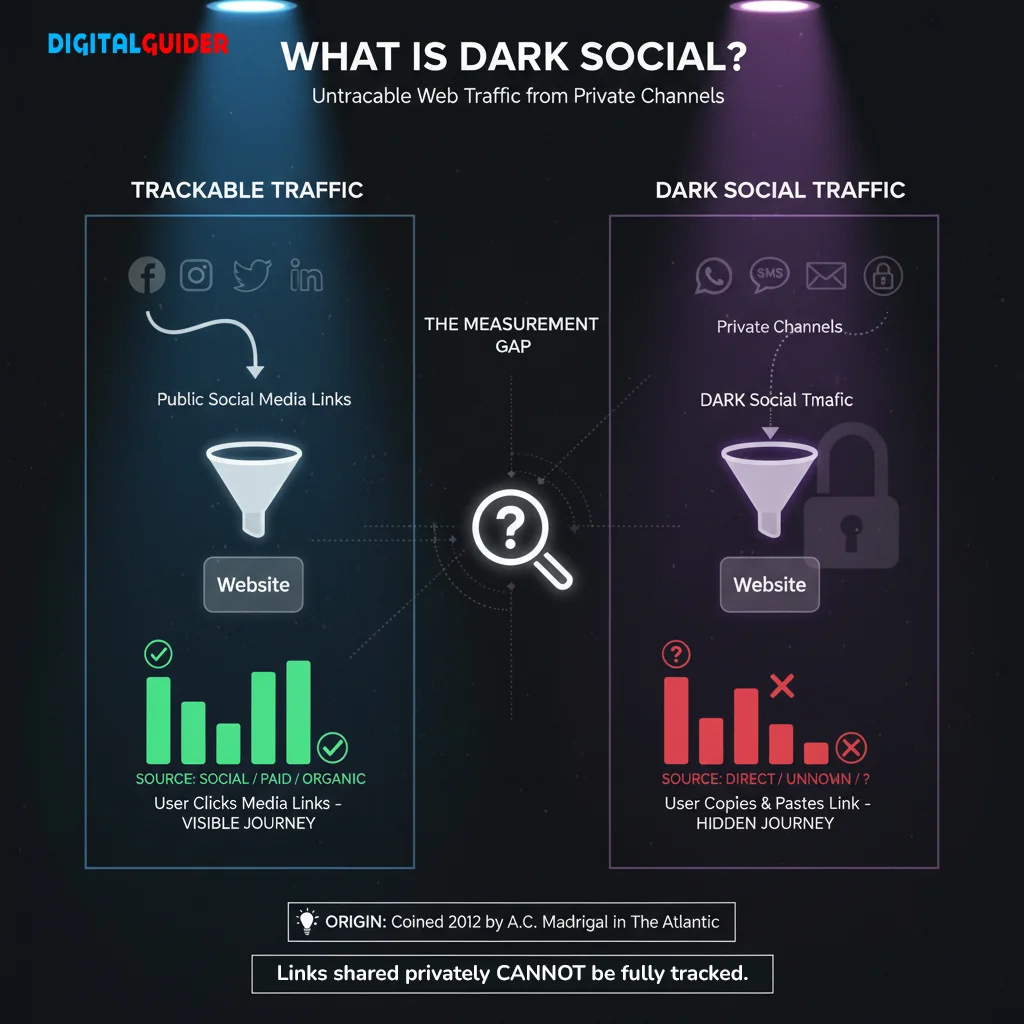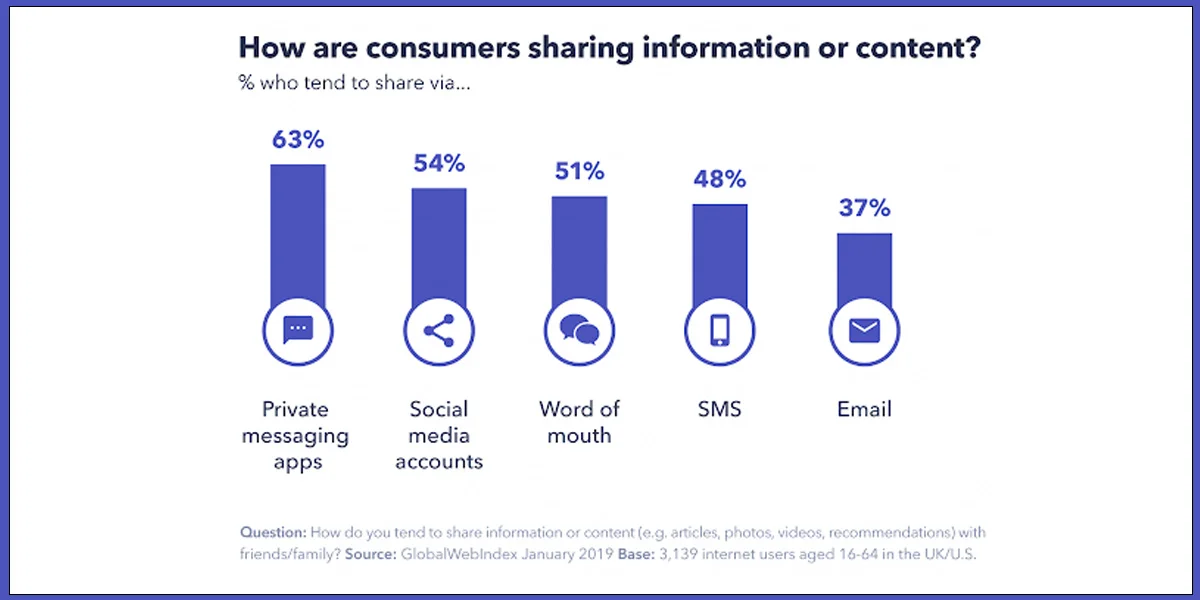Did you know that over 80% of online shares happen where analytics can’t see them?
Imagine someone reads your blog, loves it, and sends it to a friend over WhatsApp.
That friend forwards it to a colleague, who shares it in a private Slack channel. Within hours, your content has traveled far, but your reports show… nothing.
This invisible trail is called dark social. It’s the hidden side of sharing, messages, DMs, emails, and private chats that drive traffic and engagement without leaving a visible footprint.
For marketers, this means a huge chunk of social activity goes untracked, making it harder to understand audience behavior and campaign performance.
In this blog, we’ll break down what dark social really is, why it matters, and how you can track and measure these hidden shares to finally bring your unseen traffic into the light.
What is Dark Social?
Dark social refers to web traffic that comes from private or untraceable channels, such as messaging apps, email, text messages, or direct messages. Because these shares happen outside of public platforms, traditional analytics tools like Google Analytics often cannot identify the source. That’s why the traffic appears as “direct” visits, making it hard for marketers to measure or attribute accurately.
The term was first coined by Alexis C. Madrigal in The Atlantic in 2012 to describe this invisible sharing behavior.
Think of a typical content journey: a user clicks a link on social media and arrives on your site; analytics can track that easily.
But if a user copies the link from a private message or email and visits your site, the origin is hidden.
This untrackable traffic is what we call dark social.

Examples of Dark Socials
Private messaging apps
WhatsApp, Discord, Slack, or SMS → links shared in small groups or one-on-one.
Emails
Personal or professional forwards → traffic appears as direct, untrackable visits.
Facebook Messenger or Groups, Discord servers, forums → content shared in intimate communities.
Content platforms
YouTube videos or podcasts shared privately → clicks may not show up in analytics.
Employee communications
Zoom chats, Slack channels → internal sharing that drives engagement.
Word of mouth
Calls, direct messages, in-person mentions → traditional offline dark social that still impacts traffic and conversions.
How Dark Social Differs From Tracked Social?
When people share your content on public platforms like Facebook, LinkedIn, or Twitter, you can easily see how many clicks, referrals, and conversions it gets. This is called tracked social because you can see where the traffic comes from and connect it to specific campaigns.
Dark social is different. It happens in private places that can’t be tracked, like messages on WhatsApp, Slack, emails, PDFs, or offline mentions.
Users might share links, forward newsletters, or send blog posts in private chats. These shares don’t show up in analytics, so the traffic appears as “direct” visits.
Here’s a tabular presentation of basic differences between dark & tracked socials-
| Feature | Dark Social | Tracked Social |
| Visibility | Hidden; appears as “direct” traffic. | Fully visible to analytics. |
| Channels | Private messages, emails, and offline. | Public social media. (Facebook, LinkedIn, Twitter) |
| Attribution | Difficult to attribute. | Easy to measure and attribute. |
| Examples | Copy-paste links, email forwards, private chat, and offline mentions. | Clicks from social posts, campaigns, shares. |
| Analytics Tools | Often not captured by standard analytics. | Google Analytics, social dashboards. |
| Impact on Strategy | Hidden impact requires specialized tracking techniques. | Helps optimize campaigns, content, and ads. |
In summary, tracked social is clear and measurable, while dark social is hidden but still brings traffic and engagement that can’t be easily tracked.
Why Should Dark Social Be Important For Marketers?
As traditional social platforms become more algorithm-driven and privacy-conscious, private channels like messaging apps and emails have surged in importance. Here’s why marketers can’t afford to overlook dark social:
Majority of Sharing Happens Privately
A 2023 study by GlobalWebIndex (GWI) revealed that 65% of social sharing occurs through dark social channels, with messaging apps like WhatsApp, Facebook Messenger, and Instagram DMs.

Image Source: GWI
This underscores the need for marketers to recognize and engage with these private sharing behaviors.
Analytics Can Be Tricky
Take a look at your Google Analytics, that “direct traffic” slice? A lot of it isn’t people typing your URL. It’s dark social.
Sparktoro’s new study revealed that up to 70% of direct traffic comes from private shares.

Imagine a Slack link hitting the inbox of a decision-maker, invisible in your dashboard, but potentially huge for your business. This misattribution can lead to skewed data and misguided marketing strategies.
Dark Social ROI
Dark social drives tangible results:
- Grows your pipeline by reaching the right people directly.
- Shortens sales cycles, thanks to trusted recommendations.
- Boosts customer lifetime value, as referred customers tend to stay longer.
Content shared privately or via dark social converts 4–5x better than public posts.
So, ignoring dark social traffic? You’d be leaving a lot on the table.
Reaching New and Diverse Audiences
Dark social platforms often have small groups and different types of people who might not use popular social media. By using these platforms, marketers can reach new audiences and build stronger relationships.
How To Track & Measure Dark Social Traffic?
Track “Hidden Referral Traffic” with Analytics Segments
A big chunk of dark social traffic shows up as Direct in GA4. But “Direct” doesn’t always mean someone typed your URL. It often means GA4 had no idea where the visit came from.
Your main goal should be to separate meaningful private shares from everyday repeat visits.
Here are the simple steps you can take to track dark social traffic in GA4-
- Step 1: Open GA4 → Go to Explore
![]()
Step 2: Create a New Blank Exploration. Click Blank to start fresh.

- Step 3: Create a Session Segment.
Go to the left panel → Segments → + → choose session segment. Name it: Likely Dark Social
- Step 3: Create a Session Segment.
- Step 4: Filter for Direct Sessions Only
| Field | Condition | Value |
| Session source/medium | equals | (direct) / (none) |
- Step 5: Remove bookmarks & repeat visitors & add-
| Field | Condition | Value |
| Session count | equals | 1 |
Step 6: Build the Report
Now, determine which pages are getting shared privately.
- In the Variables panel:
- Click + under Dimensions → Search: Landing page + query string → Add
- Click + under Metrics → Search: Sessions → Add
- Drag:
- Landing page + query string → Rows
- Sessions → Values
- Your Likely Dark Social segment → Segment Comparisons
Your table now shows:
| Landing Page | Sessions from Private Sharing |
How to Interpret This
What appears at the top tells you what people share privately, not just publicly.
| If this page ranks high… | It means… |
| Blog post | Your insights are being discussed & passed around |
| Case study | Your proof points are used in internal evaluations |
| Comparison/alternatives page | You are in real buying conversations |
| Pricing or feature page | There’s intent, serious consideration |
Add “How Did You Hear About Us?” Form
If you’re active on dark social platforms or thinking about it, there’s a simple way to see how much they really help.
Add one small question to your website forms or contact. Just ask: “How did you hear about us?”
Here is an example of the form you can add to your website.

Image Credit: Fluent Forms
But why should you add it?
Your tracking tools might say most leads come from Google. But maybe that person first found you through your podcast. Without asking, you’d never know.
You could ask later on a call or by email, but people usually answer best when filling out a form. This way, you won’t lose that info if they don’t respond later.
With this small step, you’ll get a clearer picture of what actually drives your demos or sales. And you might be surprised, it’s often not what your software shows.
Track Dark Social Clicks With Simple UTM and Referral Links
Dark social traffic is hard to trace because people often share your content privately & these clicks don’t show up in analytics the same way as public posts.
One simple way to get some visibility is by using URL shorteners and UTM links.
Start with a URL shortener like Bitly. They make your long links shorter and cleaner, so they’re easier to share in chats or messages.
Next, add UTM tags to those links. These tags tell your analytics tool where a click came from, even if it was shared privately.
Here’s an example:
| https://yourwebsite.com/?utm_source=instagram&utm_medium=social&utm_campaign=summer_launch |
Each “utm_” part tells a piece of the story:
- utm_source: where it was shared (WhatsApp, Messenger, email, etc.)
- utm_medium: the type of traffic (dark social, social, referral, etc.)
- utm_campaign: which campaign or content it relates to.
- utm_content: what kind of link or post it was.
You can create these for free using Google’s Campaign URL Builder, then shorten them before sharing.
When people share your shortened UTM links in private messages, those clicks won’t stay completely hidden. You’ll finally start seeing which dark social shares are driving real visits or conversions.
The Real Strength of Dark Social
You can’t completely track or control dark social, and that’s what makes it special. Every private share, forwarded link, or mention in a group chat is more valuable than any fancy ad.
People trust recommendations from friends more than data from dashboards. A friend’s suggestion or a quick message in a chat can build more trust in your brand than any advertising campaign. This is where dark social shines.
Instead of trying to follow every detail, focus on getting those natural mentions. Make content that people want to share because it’s helpful, fun, or just feels real.
Dark social isn’t just a gap in your data. It shows that your brand is part of real conversations, even the ones you can’t see.
FAQs- What is Dark Social?
Dark social is traffic that comes from private sharing channels like WhatsApp, email, Slack, SMS, or DMs, where referral data is not passed to analytics. Because GA4 can’t detect the source, this traffic often appears as Direct even though the user came from a shared link.
Direct traffic includes any visit where GA4 doesn’t know the referrer. Dark social is specifically the private-sharing portion of direct traffic.
Dark social matters because private shares usually reflect trust-driven recommendations and real buying conversations. If it’s ignored, marketers underestimate which content influences research, evaluation, and decisions.
Yes. Dark social is widespread across messaging apps and internal chats. Exact percentages vary because tracking is limited, but it consistently makes up a significant portion of referral traffic, especially in B2B and high-consideration products.
You can approximate dark social by filtering Direct traffic to show first-time sessions landing on non-homepage pages. These sessions usually indicate someone clicked a link shared privately. Steps:
- GA4 → Reports → Traffic Acquisition
- Filter Session default channel group = Direct
- Add Session count = 1
- View Landing page + query string
No. UTMs help when you control the link (newsletters, share buttons, CTA links). But if someone copies and pastes the link, the UTM often gets lost. So UTMs reduce dark social leakage, but don’t eliminate it.
Partially. Social listening tools track public and semi-public conversations (Twitter, Reddit, public communities). They cannot monitor private chats in encrypted apps (WhatsApp, Messenger, Slack). So they provide context, not full attribution.
Should I use a “How did you hear about us?” form field?
Yes. A simple HDYHAU question on demo or contact forms helps capture self-reported attribution that analytics can’t. This often reveals private channels, personal referrals, and internal team recommendations.
Indirectly. Dark social sharing can drive traffic, increase repeat visits, encourage branded search, and lead to backlinks — all of which support SEO performance. The private share itself doesn’t change rankings, but the outcomes can.
Start with basic monitoring:
- Filter Direct + first-time sessions in GA4.
- Review which landing pages appear most often.
- Add UTMs to share buttons and newsletters.
- Add an HDYHAU question to key forms.
This gives immediate insight into which content travels through private channels.







